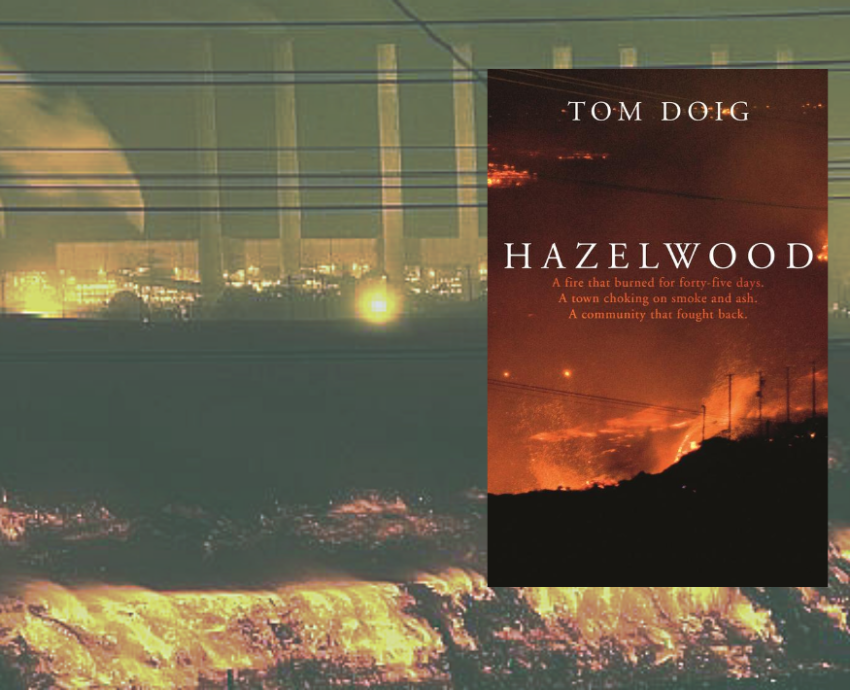
Hazelwood
By Tom Doig
Penguin Books, 2019.
304pp. $34.99
In February 2014, the Hazelwood brown coal mine in Victoria’s La Trobe Valley caught fire and for 45 days sent toxic smoke over Morwell and nearby towns. This is a story of profiteering and denial at the expense of the health of tens of thousands of people, told by those affected.
The Hazelwood coal mine is 7km long, 4km wide and 40 storeys deep, situated on the edge of Morwell, a town of 14,000 people. It is less than 400 metres from the coal face to streets. Within 20km of the mine live another 55,000 people in the towns of Moe, Traralgon, Newborough and Churchill.
The mine and power station were established about 50 years ago by the State Electricity Commission (SEC), which was privatised in the 1990s, costing 15,000 jobs in the La Trobe Valley. The Hazelwood workforce fell from 3000 to 800.
The new owner, British company International Power was subsequently taken over by GDF Suez, partly owned by the French government. GDF Suez owned 32 coal-fired power stations in many parts of the world, making a profit of A$125 billion in 2013, including $1 billion from Hazelwood and nearby Loy Yang B.
Coal dust is very flammable and fires in the mine were common. The SEC had a large fire crew and a network of sprinklers throughout the mine. Equipment was maintained and fires quickly dealt with.
After privatisation, the fire crew was drastically reduced. As pipes corroded they were removed rather than replaced, except at the coal faces actively in operation. Major fires in 2005 and 2008 took 4–5 days to put out; recommendations made then to improve access and water supply were never carried out.
A large blue gum plantation was established 2km from the mine on the western side from where the prevailing winds came. After GDF Suez got permission to divert the Morwell River and extend the mine in that direction, the plantation became even closer. There were no firebreaks around the mine and a lot of dry grass and scrub in the mine itself, which also had not been managed.
February 9, 2014 was very hot and windy. Despite warnings, there was no fire alert in place at Hazelwood and most of the fire emergency commanders were at the beach.
A bushfire raced through the blue gum plantation and sent embers into the mine. It burned for 45 days, though it took much longer than that to fully extinguish. The electric water pumps that supplied the hydrants around the mine couldn’t work because the wooden power poles had been burnt. All this was inevitable and predictable, but short-term profit was the priority.
Coal smoke and ash are highly toxic. Limits for carbon monoxide exposure are 9 parts per million (ppm) for one day per year. However, the safe level for firefighters was set at 30 ppm over an 8 hour shift. The Victorian Health Department revised this up to 70 ppm. The face masks supplied did not exclude carbon monoxide.
Coal ash covered the La Trobe Valley, entering houses despite seals on doors and windows, which few people had. The ash contained a mixture of toxic heavy metals.
The World Health Organisation advises maximum airborne fine particle readings (PM 2.5) of no more than 25 ppm. In South Morwell, adjoining the mine, readings exceeded 45 ppm on 23 days; on 7 days it was higher than 150 ppm and the peak on February 15 reached 800 ppm.
The state’s then Chief Health Officer, Rosemary Lester, said there was no concern and told people to stay home. Residents and workers experienced severe headaches, nose bleeds, increased asthma and breathing difficulties among many other health problems. People became more and more angry as they realised they were being lied to. A comparison of the normal death rate and the numbers during the months the fire burnt showed at least 23 people were killed by the smoke. The long-term effects are unknown, but many more lives will be cut short by cancers, strokes and heart and lung disease.
Mine employees and firefighters from the Metropolitan Fire Brigade and the Country Fire Authority were forbidden on pain of dismissal to talk to the media. Phone cameras were confiscated on entry.
There were two inquiries. The first one did not consider health effects. Community mobilisation, including a demonstration of more than 1500 people in Morwell on March 2, 2014, and a change of government, forced a new inquiry, which vindicated local concern about the health effects and the increased death rate.
The new Daniel Andrews Labor government demanded higher royalty payments from the company, renamed Engie, and increased the mine rehabilitation bond from $15 million to $73 million. This was still well below what would be required. WorkSafe Victoria placed repair notices on defective boilers and other parts of the power plant, estimated to cost $400 million.
Engie decided to close down Hazelwood, from March 2017, rather than pay the maintenance costs. It was no surprise, as the expected use-by date had been 2005, and Hazelwood was regarded as one of the world's most polluting coal-fired power stations. The mine is still not fire safe.
There is ongoing debate about the mine’s rehabilitation. Engie wants to flood it to create a lake, but the amount of water needed is far more than the La Trobe River can supply, and could cause South Morwell to collapse.
The book’s author, Tom Doig, a teacher of creative writing at Melbourne University, has created an excellent highly-readable account of the Hazelwood fire. Much of the book is personal stories of workers and their families and other residents of the La Trobe Valley, and their struggle against misinformation and denial. It is quite plain that the disaster was the result of privatisation and profiteering.
[Alan Broughton is an agro-ecological researcher and educator living in East Gippsland.]